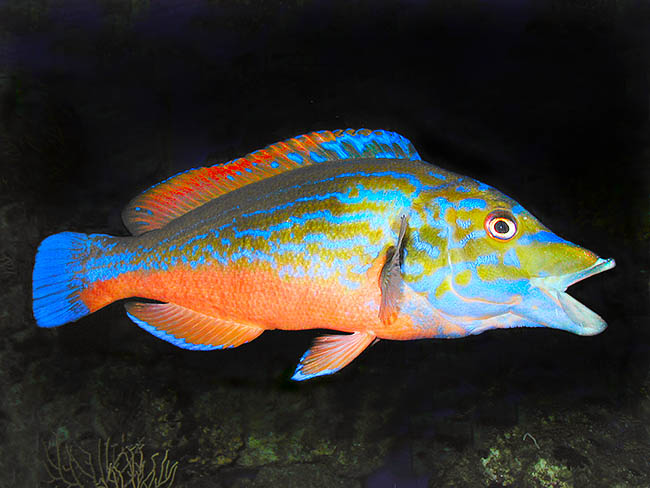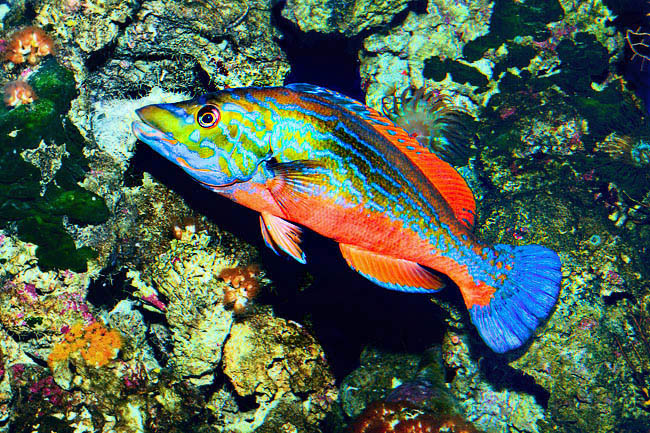Family : Labridae

Text © Giuseppe Mazza

English translation by Mario Beltramini

Male of Labrus mixtus in nuptial livery. It seems a painter's palette: difficult to do better © Giuseppe Mazza
The name of the genus and the species come both from the Latin: “labrum” = lip, referring to the large lips; and “mixtus” = shuffled, mixed, with reference to the mixture to say the least astonishing, of the colours, coming, once again, from the protogynous hermaphroditism of the species.
Zoogeography
It has a very vast distribution. Present, with a more or less high concentration, in the Mediterranean, where it is scarce in its eastern part and from Senegal to North Europe up to northern Norway and to Iceland. It is abundant in the English waters, but also at the Acores, Canary Islands and Madeira.
Ecology-Habitat
Usually, it lives solitary or in pair, among the formation of gorgonians, in dark grottos between the 40 and 80 m of depth, going down, in autumn, even at 200 m, whilst, in spring, it rises to the surface up to about the 15 m. And this is an endangered biotope which menaces the species.
Morpho-physiology
It is a protogynous hermaphroditic species: the females, while ageing, transform, in fact, in males, and reach even the 35-40 cm. Elongated body and head, laterally compressed, and mouth with big, fleshy, lips. Maxilla and mandible show a row of sharp caniniform teeth, among which stand out the 4 front ones, which are longer. There are no palatal, vomerine and lingual teeth, but there are valid pharyngeal ones. The long dorsal fin has several spiny rays in the fore part. Also the anal one, shorter, has two spines, whilst the ventral fins have only one of them. The pectoral fins are spatulate and the caudal is large and roundish.

It's a shy animal living among gorgonians. Males build a nest and care the progeny © Giuseppe Mazza
The young and the females have a reddish-yellow tint with two big black dots on the back which have originated the synonym of Labrus bimaculatus, not to talk about other black or white dots. While growing, the female exhibits around the eye a blue zone, present also on the caudal margin and on the not spiny rays of the dorsal and the anal. As dominant colour, the male has the blue, so much that the French call it “Paon bleu”, which means blue peacock, in contrast with the juvenile livery, called “Paon rouge”, that is, red peacock.
The nuptial livery of the male would seem gotten out from the palette of a painter, and you are invited to look at the nearby photos.
Ethology-Reproductive Biology
They nourish mainly of crustaceans and molluscs, but also of worms and small fishes. The reproduction takes place in spring-summer depending on the locations. The males in nuptial livery become territorial and aggressive towards the rivals who dare to get closer to their love nest, woven with seaweeds. The females may lay even 1.000 eggs, which the male hurries to fecundate. The young swim often in school with the parents and have a life expectancy of 20 years. The vulnerability index of this species is of 67 over 100.
Synonyms
Labrus bimaculatus Linnaeus, 1758; Labrus carneus Ascanius, 1772; Labrus coeruleus Ascanius, 1772; Labrus coquus Gmelin, 1789; Labrus larvatus Lowe, 1852; Labrus lineatus Bonnaterre, 1788; Labrus luvarus Rafinesque, 1810; Labrus ossifagus Linnaeus, 1758; Labrus quadrimaculatus Risso, 1827; Labrus trimaculatus Bonnaterre, 1788, Labrus variegatus Gmelin, 1789; Labrus varius Linnaeus, 1758; Labrus vetula Bloch, 1792; Sparus formosus Shaw, 1790.
→ For general information about FISH please click here.
→ For general information about BONY FISH please click here
→ For general information about CARTILAGINOUS FISH please click here.
→ To appreciate the BIODIVERSITY of BONY FISH please click here.
→ To appreciate the BIODIVERSITY of CARTILAGINOUS FISH please click here.
